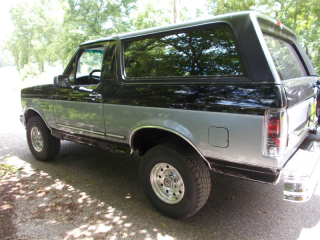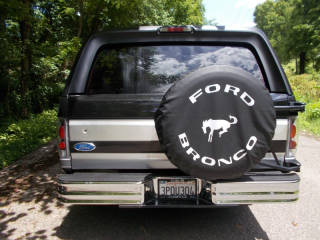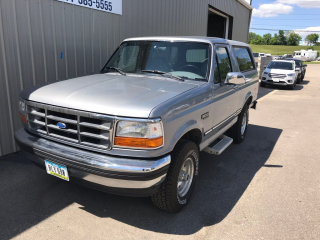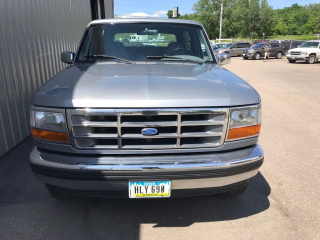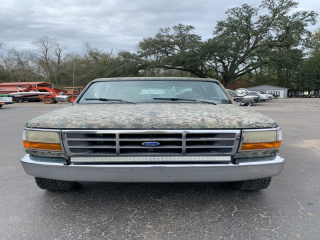The 1995 Ford Bronco is the final model year of the iconic fifth-generation (1987-1996) SUV. Known for its robust body-on-frame construction and removable hardtop, the Bronco offered a blend of off-road capability and everyday utility. Popular trims included the XLT and Eddie Bauer. Its popularity stems from its classic rugged design and versatility, making it a sought-after vehicle for both daily driving and adventure. New pricing ranged from approximately $28,000 to $35,000.
The Good
The 1995 Bronco boasts strong off-road prowess and a commanding presence that appeals to enthusiasts. Its V8 engines offer ample power, while its durable construction promises longevity for practical buyers. The spacious interior and comfortable ride make it suitable for families and road trips, representing a solid value for its capability.
The Bad
Potential buyers should be aware of common issues like rust, especially in the rocker panels and wheel wells. Transmission problems, particularly with the automatic, can arise. Electrical gremlins, such as faulty window motors and dashboard lights, are also frequently reported. Ensuring the 4WD system is in good working order is crucial.
1995 Ford Bronco: Quick Overview
- Engine Options: The 1995 Ford Bronco primarily offered two engine choices:
- 4.9L I6 (300 cu in) EFI OHV 12-valve
- 5.8L V8 (351 cu in) EFI OHV 16-valve
- Horsepower:
- 4.9L I6: Approximately 145 hp
- 5.8L V8: Approximately 205 hp
- Fuel Economy: Fuel economy is a significant drawback for the Bronco. Expect around 12-15 MPG city and 15-18 MPG highway, depending on the engine and drivetrain (2WD or 4WD).
- 0-60 Times: With the 5.8L V8, 0-60 mph times were generally in the 9-10 second range. The 4.9L I6 would be slower.
- Towing Capacity: The 1995 Ford Bronco typically had a towing capacity of around 7,000 to 8,500 pounds when properly equipped, making it capable of hauling boats, trailers, and campers.
- Trim-Level Features:
- Base/XL: Standard features included power steering, power brakes, intermittent wipers, and a basic AM/FM stereo.
- XLT: Added convenience features like power windows, power door locks, cruise control, and upgraded interior trim.
- Eddie Bauer: The most luxurious trim, offering leather seats, a premium sound system, automatic climate control, and often unique two-tone paint schemes and badging.
- Common Features Across Trims (Optional/Standard): Anti-lock brakes (ABS) on rear wheels, air conditioning, tilt steering wheel, removable rear hardtop, rear cargo area carpeting, rear privacy glass, and a spare tire mounted on the swing-away carrier.
1995 Ford Bronco Specifications
Vehicle Information
| Year | 1995 |
| Make | Ford |
| Model | Bronco |
| Trim | - |
| Style | - |
| Type | Sport Utility Vehicle Vehicle |
| Category | Standard Sport Utility Vehicle Medium Truck |
Manufacturing Details
| Made In | United States |
| Manufacturing City | WAYNE |
Dimensions
| Doors | 2-Door |
| Curb Weight | - |
| Gross Vehicle Weight Rating | 33001 pounds |
| Overall Height | - |
| Overall Length | - |
| Overall Width | - |
| Wheelbase Length | - |
| Standard Seating | - |
Engine & Performance
| Engine | 5.0L V8 |
| Engine Size | 5L |
| Engine Cylinders | 8 |
| Transmission | - |
| Transmission Type | - |
| Transmission Speeds | - |
| Drivetrain | Four-Wheel Drive |
Additional Features
| Anti-Brake System | - |
| Steering Type | - |
Pricing
| Manufacturer Suggested Retail Price (MSRP) | - |
| Invoice Price | - |
| Delivery Charges | - |
Vehicle History Report
Vehicle
Specifications
Specifications
Ownership
History
History
All History
Events
Events
NMVTIS Title
History Check
History Check
Salvage/Rebuilt
Check
Check
Accident
Check
Check
Theft
Check
Check
Open Lien
Check
Check
Past Sale
Listings
Listings
Safety
Recalls
Recalls
Odometer
Check
Check
Market Price
Analysis
Analysis
What Problems Does the 1995 Ford Bronco Have?
The 1995 Ford Bronco, being the final year of its generation, generally benefited from accumulated improvements. However, certain issues are consistently reported by owners. A primary concern is rust, particularly affecting the body panels like the rocker panels, rear quarter panels, and the frame itself. This is more prevalent in areas with harsh winters and road salt.
Transmission issues, especially with the electronic automatic transmissions (E4OD and 4R70W), can be a significant expense if they fail. Symptoms can include slipping gears, delayed engagement, or complete failure. Regular fluid changes and proper cooling are crucial for longevity. The 4.9L inline-six engine is generally robust, but the 5.8L V8 can suffer from intake manifold gasket leaks, leading to coolant loss and potential overheating.
Electrical problems are also a common theme. This can range from malfunctioning power windows and locks to intermittent issues with the dashboard gauges and warning lights. The transfer case engagement system, whether manual or electronic, can sometimes develop issues, so verifying proper 4WD operation is important. Spark plug blowouts on the 5.8L V8 have also been noted. While specific recalls for the 1995 model year concerning major powertrain failures are less common than for earlier years, it is always advisable to check for any outstanding safety recalls through official channels. Long-term reliability hinges heavily on consistent maintenance, particularly fluid changes for the engine, transmission, and differentials, as well as addressing rust proactively. While the core mechanical components are stout, wear and tear on supporting systems are to be expected in a vehicle of this age.
Transmission issues, especially with the electronic automatic transmissions (E4OD and 4R70W), can be a significant expense if they fail. Symptoms can include slipping gears, delayed engagement, or complete failure. Regular fluid changes and proper cooling are crucial for longevity. The 4.9L inline-six engine is generally robust, but the 5.8L V8 can suffer from intake manifold gasket leaks, leading to coolant loss and potential overheating.
Electrical problems are also a common theme. This can range from malfunctioning power windows and locks to intermittent issues with the dashboard gauges and warning lights. The transfer case engagement system, whether manual or electronic, can sometimes develop issues, so verifying proper 4WD operation is important. Spark plug blowouts on the 5.8L V8 have also been noted. While specific recalls for the 1995 model year concerning major powertrain failures are less common than for earlier years, it is always advisable to check for any outstanding safety recalls through official channels. Long-term reliability hinges heavily on consistent maintenance, particularly fluid changes for the engine, transmission, and differentials, as well as addressing rust proactively. While the core mechanical components are stout, wear and tear on supporting systems are to be expected in a vehicle of this age.
How long will the 1995 Ford Bronco last?
With diligent maintenance, a 1995 Ford Bronco can easily surpass 200,000 miles, with many examples exceeding 250,000 or even 300,000 miles. The robust frame and strong powertrain options contribute to its longevity. However, time and mileage will inevitably lead to wear on components. Rust remains a critical factor, as significant corrosion can compromise structural integrity and render a vehicle uneconomical to repair. Transmission health is another key indicator; a well-maintained automatic transmission can last hundreds of thousands of miles, while a neglected one may fail much sooner. Electrical systems and interior components may also show their age, but these are typically less critical to the vehicle's overall mechanical durability than the powertrain and chassis.
What Technology & Safety Features are Included?
The 1995 Ford Bronco, in line with its era, offers a relatively basic set of technological and safety features compared to modern vehicles.
Entertainment: Standard entertainment typically consisted of an AM/FM radio, often with a cassette player. Optional upgrades included a CD player and premium sound systems, particularly on the higher trims like the Eddie Bauer. The focus was on functionality rather than advanced multimedia integration.
Built-in Tech: Features were generally limited to convenience items. Power windows, power door locks, cruise control, and a tilt steering wheel were available, often standard on higher trims. Automatic climate control was an option on the Eddie Bauer. The removable rear hardtop was a unique feature that offered an open-air experience.
Driver-Assistance Features: Advanced driver-assistance systems were virtually non-existent in 1995. The primary safety technologies were mechanical. Anti-lock brakes (ABS) were typically available, but usually only for the rear wheels, providing improved stability during hard braking on slippery surfaces.
Safety Features: Standard safety features included three-point seatbelts in the front and lap belts in the rear. The vehicle's body-on-frame construction offered a degree of inherent crashworthiness. Airbags were not standard equipment for the 1995 model year; drivers and passengers relied on seatbelts and the vehicle's structural integrity.
Crash-Test Ratings: Specific crash-test ratings for the 1995 Ford Bronco from agencies like the NHTSA or IIHS are not readily available in the detailed format seen today. However, vehicles of this era generally performed less favorably in frontal and side-impact tests compared to contemporary standards. The tall riding height and robust construction provided some protection, but the lack of advanced safety systems limited its overall safety profile by today's metrics.
Entertainment: Standard entertainment typically consisted of an AM/FM radio, often with a cassette player. Optional upgrades included a CD player and premium sound systems, particularly on the higher trims like the Eddie Bauer. The focus was on functionality rather than advanced multimedia integration.
Built-in Tech: Features were generally limited to convenience items. Power windows, power door locks, cruise control, and a tilt steering wheel were available, often standard on higher trims. Automatic climate control was an option on the Eddie Bauer. The removable rear hardtop was a unique feature that offered an open-air experience.
Driver-Assistance Features: Advanced driver-assistance systems were virtually non-existent in 1995. The primary safety technologies were mechanical. Anti-lock brakes (ABS) were typically available, but usually only for the rear wheels, providing improved stability during hard braking on slippery surfaces.
Safety Features: Standard safety features included three-point seatbelts in the front and lap belts in the rear. The vehicle's body-on-frame construction offered a degree of inherent crashworthiness. Airbags were not standard equipment for the 1995 model year; drivers and passengers relied on seatbelts and the vehicle's structural integrity.
Crash-Test Ratings: Specific crash-test ratings for the 1995 Ford Bronco from agencies like the NHTSA or IIHS are not readily available in the detailed format seen today. However, vehicles of this era generally performed less favorably in frontal and side-impact tests compared to contemporary standards. The tall riding height and robust construction provided some protection, but the lack of advanced safety systems limited its overall safety profile by today's metrics.
What Colors Options are Available?
1995 Ford Bronco Prices and Market Value
When new, the 1995 Ford Bronco typically ranged from approximately $28,000 for a base model to over $35,000 for a fully-equipped Eddie Bauer trim. As a vehicle from the mid-90s, the Bronco has experienced significant depreciation from its original MSRP. However, in recent years, its resale value has seen a notable increase, driven by its cult classic status, iconic design, and off-road heritage.
Current used market prices for a 1995 Ford Bronco vary widely based on condition, mileage, trim level, and originality. Expect to see prices anywhere from $5,000 for a project vehicle to $20,000-$40,000 or even more for exceptionally well-maintained, low-mileage examples, especially rarer trims or those with desirable modifications. Factors affecting resale value include the absence of rust, original paint and interior condition, mechanical soundness, and the presence of desirable options or a clean history.
Current used market prices for a 1995 Ford Bronco vary widely based on condition, mileage, trim level, and originality. Expect to see prices anywhere from $5,000 for a project vehicle to $20,000-$40,000 or even more for exceptionally well-maintained, low-mileage examples, especially rarer trims or those with desirable modifications. Factors affecting resale value include the absence of rust, original paint and interior condition, mechanical soundness, and the presence of desirable options or a clean history.
1995 Ford Bronco Cost of Ownership
Owning a 1995 Ford Bronco can be a mixed bag in terms of cost. Fuel costs are a significant factor due to the V8 engines' thirst, typically averaging 12-18 MPG. Insurance premiums can vary, potentially being higher for classic or enthusiast vehicles. Maintenance is generally straightforward but can become costly if major repairs are needed, especially for transmission or significant rust remediation. Parts availability is good, but specialized components can be pricier. While not economical to run daily due to fuel consumption, its long-term durability and strong used market value can offset some ownership costs for dedicated enthusiasts. It's more costly to own than a modern economy car but offers unique value for its capability.
1995 Ford Bronco Fuel Efficiency
Fuel Type
Gasoline
Fuel Capacity
-
City Mileage
-
Highway Mileage
-
1995 Ford Bronco Safety Rating
NHTSA
1995 Ford Bronco Insurance
Insurance for a 1995 Ford Bronco is moderately priced, reflecting its status as a Sport Utility Vehicle Vehicle with strong safety ratings and
reasonable repair costs.
reasonable repair costs.
How Does the 1995 Ford Bronco Compare to Other Sport Utility Vehicle Vehicle?
The 1995 Ford Bronco competed in the full-size, body-on-frame SUV segment against strong rivals such as the Chevrolet K1500 Blazer/Tahoe, GMC Yukon, Dodge Ramcharger, and Jeep Grand Cherokee (though the Grand Cherokee was slightly smaller/more car-like).
Performance: The Bronco's V8 options provided respectable power for its era, especially for towing and off-roading. The K1500 Blazer/Tahoe offered comparable or superior V8 power and refinement. The Dodge Ramcharger was also a potent contender. The Jeep Grand Cherokee, especially with its optional V8, offered more refined on-road performance and a more modern feel, but typically less extreme off-road capability than the Bronco.
Features: The Bronco, particularly in Eddie Bauer trim, offered a good level of comfort and features for its time, including available leather and premium audio. However, rivals like the Tahoe/Yukon often provided more advanced features and a more modern interior design. The Jeep Grand Cherokee was generally considered to have a more sophisticated and contemporary interior and feature set.
Reliability: The Bronco has a reputation for robust mechanicals, but prone to rust and transmission issues. The Chevy/GMC counterparts were generally considered reliable, though they also had their share of common problems, often related to electronics and specific engine components (e.g., intake manifold gaskets on Vortec V8s). The Dodge Ramcharger, while rugged, could be less reliable in terms of long-term electrical and interior component durability. The Grand Cherokee offered decent reliability but often lagged behind the Bronco or Tahoe/Yukon in terms of sheer ruggedness for extreme use.
Price: New, the Bronco was competitively priced. On the used market, the Bronco has seen its value appreciate significantly, often commanding higher prices than comparable year Tahoe/Yukons or Ramchargers due to its iconic status. The Grand Cherokee can often be found at lower used prices for equivalent models.
Alternatives:
Performance: The Bronco's V8 options provided respectable power for its era, especially for towing and off-roading. The K1500 Blazer/Tahoe offered comparable or superior V8 power and refinement. The Dodge Ramcharger was also a potent contender. The Jeep Grand Cherokee, especially with its optional V8, offered more refined on-road performance and a more modern feel, but typically less extreme off-road capability than the Bronco.
Features: The Bronco, particularly in Eddie Bauer trim, offered a good level of comfort and features for its time, including available leather and premium audio. However, rivals like the Tahoe/Yukon often provided more advanced features and a more modern interior design. The Jeep Grand Cherokee was generally considered to have a more sophisticated and contemporary interior and feature set.
Reliability: The Bronco has a reputation for robust mechanicals, but prone to rust and transmission issues. The Chevy/GMC counterparts were generally considered reliable, though they also had their share of common problems, often related to electronics and specific engine components (e.g., intake manifold gaskets on Vortec V8s). The Dodge Ramcharger, while rugged, could be less reliable in terms of long-term electrical and interior component durability. The Grand Cherokee offered decent reliability but often lagged behind the Bronco or Tahoe/Yukon in terms of sheer ruggedness for extreme use.
Price: New, the Bronco was competitively priced. On the used market, the Bronco has seen its value appreciate significantly, often commanding higher prices than comparable year Tahoe/Yukons or Ramchargers due to its iconic status. The Grand Cherokee can often be found at lower used prices for equivalent models.
Alternatives:
- Similar: 1995 Chevrolet K1500 Blazer/Tahoe or GMC Yukon offer similar capability and a more refined ride.
- Off-road Focused: If extreme off-road capability is the priority and a slightly smaller footprint is acceptable, a Jeep Cherokee XJ (though smaller) or a Toyota 4Runner (earlier generations) are excellent, often more reliable, choices.
- More Refined: For a more comfortable on-road experience with decent off-road chops, a 1995 Jeep Grand Cherokee offers a more car-like driving feel and a more modern interior.
Final Verdict: Is the 1995 Ford Bronco a Good Sport Utility Vehicle Vehicle?
The 1995 Ford Bronco is ideal for off-road enthusiasts, classic car collectors, and those seeking a rugged, versatile SUV with iconic styling. It's a great choice for weekend adventurers, light towing, or as a stylish daily driver for those who appreciate its character. It is worth buying, but only if you prioritize its unique appeal and are prepared for the potential costs associated with owning an older vehicle. Buying used is the only option. Focus on examples with minimal rust, a well-documented maintenance history, and a functioning 4WD system. Higher trims like the XLT or Eddie Bauer offer more comfort and features, but base models are simpler and potentially easier to maintain. Be prepared for higher fuel consumption and potential repair bills, but the rewarding experience of owning a classic Bronco can outweigh these factors for the right buyer.
